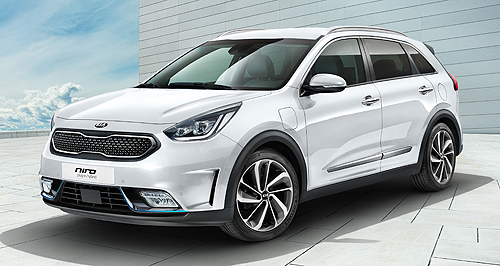Make / Model Search
News - KiaGeneva show: Kia still cold on hybridsUnplugged: As well as the Niro crossover, Kia lifted the lid on the Optima Sportswagon plug-in at Geneva. Kia rejects Niro and Optima wagon plug-ins for AustraliaGallery Click to see larger images 8 Mar 2017 By TIM NICHOLSON in GENEVA KIA Motors Australia (KMAu) says it will hold off on importing electrified vehicles Down Under until there is sufficient government support and appropriate infrastructure across the country. The Korean car-maker’s Australian chief operating officer Damien Meredith has confirmed that the pair of plug-in hybrid models announced at the Geneva motor show would not be coming to local showrooms. Kia lifted the covers off a plug-in version of the Niro hybrid crossover, and a new plug-in hybrid variant of its European-market Optima Sportswagon. Mr Meredith told journalists ahead of the Swiss show that Kia was committed to alternative powertrain technology,“We understand that we have to get more hybrids, more electric and more fuel-cell vehicles into market over the next ‘X’ amount of years, there’s no question about that,” he said. “The Niro is a smaller footprint than the Sportage, but obviously because of its hybrid (powertrain), it is far more expensive. I didn’t see any commercial value at that point in time.” While Mr Meredith acknowledged that companies like Kia can help push a shift in consumer interest towards electrified cars through new product, he said it was government that needed to lead the way. “We have to be commercial smart, but we have got a responsibility to make sure we have got those vehicles coming into the country to drive the change,” he said. “I will also say that I think when you look at Australia, we need government change to drive that.” Mr Meredith added that of all of the alternative powertrain tech, he was “a great believer in” hydrogen fuel-cell power, something Kia’s Hyundai Motor Corporation parent company has been busy developing. “I think once we start getting serious about fuel-cell, that’s where I see it. Saying that, there is a lot of infrastructure cost in that too.” He also said change can happen if car-makers work together. “I think collectively as an industry, we have got a responsibility to do something about it.” While KMAu has been cold on hybrids and EVs for some time now, Kia Motors Corporation has previously stated it wanted to improve average fleet fuel efficiency by 25 per cent by 2020, compared to 2014 levels. The Niro plug-in uses Kia’s 1.6-litre ‘Kappa’ four-cylinder GDI petrol engine that produces 77kW and 147Nm, paired with a high-capacity 8.9kWh lithium-polymer battery pack and a 44.5kW electric motor. The total system output is 104kW/265Nm, ensuring a zero to 100km/h dash time of 10.8 seconds, which Kia says is 0.7s quicker than the non-plug-in Niro already on sale in Europe and other markets. Kia has not locked down the electric only driving range but says its engineers are “targeting” 55km of petrol-free driving for the new variant. It is fitted with a six-speed dual-clutch automatic transmission and CO2 emissions will be less than 30g/km, according to Kia, which is a big drop compared with the 88g/km figure of the standard hybrid Niro. Assisting the efficiency of the Niro is regenerative braking that stores the energy and recharges the battery pack when coasting, as well as a Predictive Energy Control function that uses the satellite navigation and cruise control to anticipate topographical changes and determine the best time to recharge the battery. Kia is yet to advise the charging time for the Niro plug-in, but it will have a braked towing capacity of up to 1300kg. The Niro also gains styling flourishes inside and out to differentiate it from its standard hybrid sibling. Exterior changes include a satin chrome grille surround, more chrome brightwork with a metallic blue finish on the front and rear bumpers, full LED headlights, Eco Plug-in badges and 16-inch alloy wheels that are designed to reduce wind resistance. Inside, the Niro has blue stitching on the upholstery and blue air vent surrounds as well as a 7.0-inch full TFT colour instrument cluster that displays battery charge levels and offering suggestions on more efficient driving. The 8.0-inch central infotainment screen has also been calibrated to display the current electric-only driving range and to locate the nearest charging stations. For the Optima Sportswagon plug-in, Kia engineers are targeting an electric-only driving range of 61km. Under the long bonnet is the 115kW/189Nm 2.0-litre ‘Nu’ four-cylinder GDI petrol unit paired with an electric motor and an 11.26kWh lithium-ion polymer battery pack for a full system output of 151kW/375Nm. The targeted fuel economy figure is 1.5 litres per 100km on the combined cycle, while Kia is hoping for a CO2 emissions figure of 34g/km. Like the Optima plug-in sedan that was revealed at last year’s Chicago motor show, the electrified Sportwagon features reprofiled, aerodynamically-efficient bumpers, side skirts and wheels, chrome brightwork, and ‘ECO plug-in’ badging to differentiate it from the internal combustion variants. The reveal of the Optima Sportswagon plug-in hybrid comes exactly a year after the load-lugging wagon was uncovered in petrol guise at last year’s Geneva show.  Read more |
Click to shareMotor industry news |























Facebook Twitter Instagram